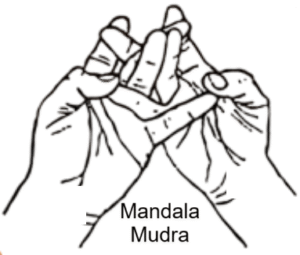Mandala Mudra
Introduction
Mandala Mudra is a sacred hand gesture and meditative practice symbolizing wholeness, unity, and the cyclical nature of existence. The word Mandala in Sanskrit means “circle,” representing completeness, harmony, and the interconnectedness of the universe.
This mudra is often used in meditation, tantric rituals, and yoga practices to invoke balance, enhance concentration, and connect the practitioner with universal energy. It is commonly practiced in Buddhist, Hindu, and yogic traditions as a tool for centering the mind and opening the heart and higher consciousness.
Meaning
Mandala = Circle, wholeness, cosmos, eternal cycle.
Mudra = Seal, gesture.
Thus, Mandala Mudra signifies the “seal of unity and completeness,” symbolizing the infinite cycle of creation, preservation, and dissolution.
How to Perform (Practice)
Sit comfortably in Padmasana, Sukhasana, or Vajrasana, with a straight spine and relaxed shoulders.
Sit comfortably with your back straight and focus on calming your breath.
As you calm your mind and lower your heart rate, imagine a majestic mountain situated amidst a great sea.
Pull the fingers of both your hands up and down with your palms in between. Press the tip of the opposite thumb at the tip of each small finger.
Fold each index finger so that its tip reaches the tip of the opposite middle.
Hold the fingers of the fingers and position them in such a way that they are perpendicular to the top of your palms. Press the back of each finger to its counterpart.
Anamika is the symbol of the sacred mountain Meru which is surrounded by the cosmic ocean.
Close your eyes, take deep breaths, and focus on the circle formed by the hands as a symbol of wholeness and harmony.
Practice for 10–20 minutes during meditation or pranayama.
Benefits
Physical Benefits
Supports digestion and abdominal organs when placed at the solar plexus.
Enhances respiratory efficiency by expanding awareness of diaphragmatic breathing.
Improves circulation and lymphatic flow by calming the body.
Energetic Benefits
Balances prana (life force) across all five vayus.
Activates and harmonizes solar plexus (Manipura) and heart (Anahata) chakras.
Promotes a sense of wholeness, grounding, and stability.
Connects personal energy with cosmic energy.
Mental & Emotional Benefits
Enhances concentration and meditation depth.
Reduces feelings of fragmentation or stress.
Cultivates inner harmony, clarity, and completeness.
Symbolically heals emotional wounds by restoring a sense of unity and belonging.
Contraindications
Not suitable for those experiencing severe restlessness or hyperactivity (may intensify inner focus too strongly).
Should be avoided in acute digestive discomfort or abdominal inflammation if placed at the solar plexus.
People with emotional trauma may initially find deep meditative states overwhelming.
Anatomy & Physiology
Promotes relaxation response via the parasympathetic nervous system.
Influences the solar plexus → regulating digestive enzymes and metabolic activity.
Improves oxygenation and diaphragm activity for better breathing.
Enhances heart coherence, synchronizing heartbeat with breath rhythm.
Kinesiology
The circular hand shape represents energy looping back into itself, symbolizing conservation and balance.
Gentle engagement of finger flexors and extensors creates a stable but non-rigid posture.
Activates proprioceptive feedback, enhancing body–mind connection.
Neurology
Stimulates somatosensory cortex through tactile awareness of joined fingers.
Enhances neuroplasticity via focused attention and visualization of wholeness.
Regulates autonomic nervous system balance by deepening meditative states.
Activates frontal lobes (attention, decision-making) and limbic system (emotional integration).
Duration of Practice
10–20 minutes, once or twice daily.
Can be practiced during meditation, mantra chanting, or pranayama.
For therapeutic use (stress, anxiety, digestion), practice consistently for 4–6 weeks.
Counter Mudra
Prithvi Mudra → grounding if one feels scattered after Mandala Mudra.
Hridaya Mudra → for emotional release if deep focus stirs up hidden emotions.
Hakini Mudra → for enhancing concentration in a more cognitive manner.
Conclusion
Mandala Mudra is a symbol of wholeness and unity, guiding practitioners toward balance, harmony, and inner peace. It integrates body, mind, and spirit by forming a circle—the most ancient symbol of infinity and completeness. Practiced regularly, it enhances meditation, balances energy, supports digestion, and nurtures inner calm. By embodying the cosmic circle, this mudra helps us experience a profound sense of belonging within the universe.
FAQ
Q1. What is Mandala Mudra used for?
It is used for meditation, enhancing unity, and balancing inner energy.
Q2. Can beginners practice it?
Yes, it is gentle and safe for beginners.
Q3. Which chakra does it activate?
Primarily Manipura (solar plexus) and Anahata (heart chakra).
Q4. Does it help with stress?
Yes, it calms the nervous system and brings emotional stability.
Q5. Is it linked to Buddhist or Hindu traditions?
Both—Buddhism uses it in mandala meditations, while Hindu yoga associates it with wholeness and pranic balance.
References
Gertrud Hirschi – Mudras: Yoga in Your Hands.
Swami Satyananda Saraswati – Asana, Pranayama, Mudra, Bandha.
Joseph Campbell – The Power of Myth (on mandala symbolism).
Lama Anagarika Govinda – The Foundations of Tibetan Mysticism.
Modern research on hand mudras in meditation and stress reduction.

